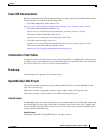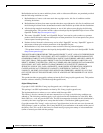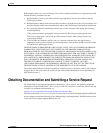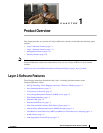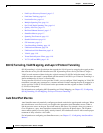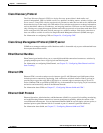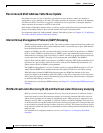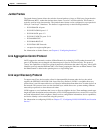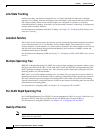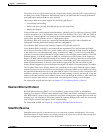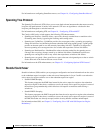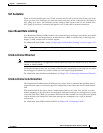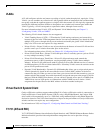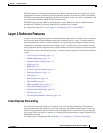
1-5
Software Configuration Guide—Release 15.0(2)SG
OL-23818-01
Chapter 1 Product Overview
Layer 2 Software Features
Jumbo Frames
The jumbo frames feature allows the switch to forward packets as large as 9216 bytes (larger than the
IEEE Ethernet MTU), rather than declare those frames “oversize” and discard them. This feature is
typically used for large data transfers. The jumbo frames feature can be configured on a per-port basis
on Layer 2 and Layer 3 interfaces. The feature is supported only on the following hardware:
• WS-X4306-GB: all ports
• WS-X4232-GB-RJ: ports 1-2
• WS-X4418-GB: ports 1-2
• WS-X4412-2GB-TX: ports 13-14
• WS-4648-RJ45V-E
• WS-X4648+RJ45V+E
• WS-X4706-10GE linecards
• on supervisor engine uplink ports
For information on Jumbo Frames, see Chapter 6, “Configuring Interfaces.”
Link Aggregation Control Protocol
LACP supports the automatic creation of EtherChannels by exchanging LACP packets between LAN
ports. LACP packets are exchanged only between ports in passive and active modes. The protocol
"learns" the capabilities of LAN port groups dynamically and informs the other LAN ports. After LACP
identifies correctly matched Ethernet links, it facilitates grouping the links into an EtherChannel. Then
the EtherChannel is added to the spanning tree as a single bridge port.
Link Layer Discovery Protocol
To support non-Cisco devices and to allow for interoperability between other devices, the switch
supports the IEEE 802.1AB LLDP. Link Layer Discovery Protocol (LLDP) is a neighbor discovery
protocol that is used for network devices to advertise information about themselves to other devices on
the network. This protocol runs over the data-link layer, which allows two systems running different
network layer protocols to learn about each other.
LLDP supports a set of attributes that it uses to discover neighbor devices. These attributes contain type,
length, and value descriptions and are referred to as TLVs. LLDP supported devices can use TLVs to receive
and send information to their neighbors. Details such as configuration information, device capabilities,
and device identity can be advertised using this protocol.
For information on configuring LLDP, see Chapter 27, “Configuring LLDP, LLDP-MED, and Location
Service.”



